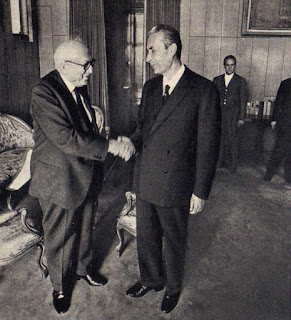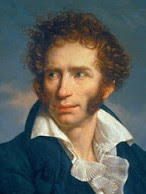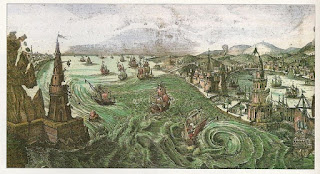NEW - Pietro Nenni - politician
Orphan who became influential leader of Italian Socialist Party
The politician Pietro Sandro Nenni, who was a major figure of the Italian left for five decades, was born on this day in 1891 in Faenza in Emilia-Romagna. Nenni was general secretary of the Italian Socialist Party (PSI) on three occasions and rose to high office in the Italian government, twice serving as foreign affairs minister and several times as deputy prime minister, notably under the progressive Christian Democrat Aldo Moro in the centre-left coalitions of the 1960s. He was a recipient of the Stalin Peace Prize in 1951 but returned the $25,000 that came with the honour in protest at the Soviet invasion of Hungary in 1956. Born into a peasant family, Nenni lost both his parents before he was five years old and grew up in an orphanage, having been placed there by the aristocratic landowners for whom his father had worked. His experiences there seemed to stir in him a desire to rebel against authority. He was only nine years old when, on learning of the assassination of King Umberto I by the anarchist Gaetano Bresci, he is said to have written ‘Viva Bresci’ on a wall in the orphanage. Read more…
_________________________________________________________________
Vito Antuofermo - world champion boxer
Farmer's son from deep south who won title in Monaco
Vito Antuofermo, who went from working in the fields as a boy to becoming a world champion in the boxing ring, was born on this day in 1953 in Palo del Colle, a small town in Apulia, about 15km (9 miles) inland from the port of Bari. He took up boxing after his family emigrated to the United States in the mid-1960s. After turning professional in 1971, he lost only one of his first 36 fights before becoming European light-middleweight champion in January 1976. In his 49th fight, in June 1979, he beat Argentina's Hugo Corro in Monaco to become the undisputed world champion in the middleweight division. Antuofermo's success in the ring, where he won 50 of his 59 fights before retiring in 1985, opened the door to a number of opportunities in film and television and he was able to settle in the upper middle-class neighbourhood of Howard Beach in New York, just along the coast from John F Kennedy Airport. He and his wife Joan have four children - Lauren, Vito Junior, Pasquale and Anthony. He grew up in rather less comfort. The second child of Gaetano and Lauretta Antuofermo, who were poor tenant farmers, he was working in the fields from as young as seven years old. Read more…
___________________________________________________________________
Ezechiele Ramin – missionary
Priest from Padua who was murdered in Brazil
Ezechiele Ramin, a Comboni missionary who was shot to death by hired killers after standing up for the rights of peasant farmers and traditional tribesmen in a remote rural area in Brazil, was born on this day in 1953 in Padua. Ramin was only 32 when he was murdered in July 1985, having worked in the South American country for about a year and a half. He had already completed missionary assignments in North and Central America, worked to help victims of the Irpinia earthquake in Campania and organised a demonstration against the Camorra in Naples before being posted to Brazil. He was based in the state of Rondônia, an area in the northwest of Brazil next to the border with Bolivia, where small farmers found themselves oppressed, by legal and illegal means, by wealthy landowners, and where government measures had been introduced to curb the freedom of the indigenous Suruí tribes. Ramin, an easy-going and popular man who amused himself by making sketches and playing the guitar, tried to solve the problems by arranging for a lawyer, paid for by the Brazilian Catholic Church through the Pastoral Land Commission, to act on behalf of the peasant farmers to see that their legal rights were properly observed. Read more…
________________________________________________________________
Ferdinando Carulli - classical guitarist and composer
Neapolitan wrote first guide to playing the instrument
The composer Ferdinando Carulli, who published the first complete method for playing the classical guitar as well as writing more than 400 works for the instrument, was born on this day in 1770 in Naples. Carulli was also influential in changing the design of the guitar, which had a smaller body and produced a less resonant sound when he started out, to something much more like the classical guitars of today. The son of an intellectual advisor to the Naples Jurisdiction, Carulli first trained as a cellist and received instruction in musical theory from a local priest. He became interested in the guitar in his 20s and became so enthusiastic about the instrument he decided to devote himself to it entirely. The guitar was little played and there were no guitar teachers in Naples in the late 18th century, so Carulli had to devise his own method of playing. In time, he began to give concerts in Naples, playing some pieces of his own composition. These were popular, attracting large audiences who enjoyed the different sound that the guitar produced. This encouraged Carulli to venture further afield and he engaged on a tour of Europe. Read more…
_________________________________________________________________
Pope Gregory XV
Legally-trained pontiff was against witchcraft and for secret ballots
Gregory XV, who was christened Alessandro Ludovisi, became Pope on this day in 1621. He was the last Pope to issue a papal ordinance against witchcraft with his ‘Declaration against Magicians and Witches’, put out in March 1623. He was already 67 years of age and in a weak state of health when he was chosen as Pope and relied heavily on his 25-year-old nephew, Ludovico Ludovisi, to assist him in his duties. Born in Bologna in 1554, the young Alessandro Ludovisi was educated at a Jesuit college in Rome before going to Bologna University to study law. He worked in various roles for the church until he was appointed Archbishop of Bologna in 1612, having at some stage been ordained. In 1616 he was sent by Pope Paul V to mediate between Charles Emmanuel 1, Duke of Savoy and Philip III of Spain, who were involved in a dispute. The Pope elevated him to the rank of Cardinal in the same year. He went to Rome after the death of Pope Paul V to take part in the conclave. He was chosen as Pope on February 9, 1621, the last Pope to be elected by acclamation. His nephew, Ludovico, was made a cardinal. Read more…
Home






























